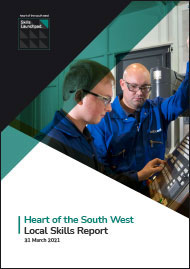3 Skills Strengths and Needs
This chapter briefly summarizes the evidence base set out in Annex A and B of this document.
This can be found in full at skillslaunchpad.org.uk/skills-strategy/
Overview
Located in the peninsula of the South West of England, the Heart of the South West is one of the country’s largest LEP areas. Its economy is broadly balanced, and while many of its industrial strengths capitalise on its rich endowment of environmental assets, it is has high-tech specialisms in aerospace, photonics and ship building. Strategies in place to benefit from on the golden opportunities afforded by marine, nuclear, aerospace and advanced engineering, data analytics, health and care and rural productivity. Its economic strategy envisions doubling the size of the economy but with an emphasis on clean and inclusive growth.
In order to meet this challenge, the HotSW will need to unlock the region’s productive potential over the next decade, whilst creating quality employment opportunities for its residents in the broader context of Covid-19 recovery and recalibration of the UK’s trading relationship with the European Union. Skills will be integral to realising these ambitions. Covid-19 has had a disproportionate impact on parts of the area, due to the HotSW’s heavy reliance on tourism, hospitality, and retail activity. Productivity is also traditionally low by national standards due to a combination of factors relating not only to skills, but business structure and innovation. Recovery and growth will therefore involve maximising the economies of industrial clusters and improving leadership and management skills so that local businesses and organisations are more efficient, fully utilising the capabilities of all staff, and adopting the latest technologies and management practices.
Key Economic Features
- A mixed geography The Heart of the South West is one of England’s most geographically diverse LEP areas, encompassing significant rural and coastal areas, alongside core urban centres.
- Low productivity overall, but significant economic diversity across the HotSW’s geography In 2018, GVA per head in the HotSW was approximately 18% lower than the national average. This however disguises substantial differences within the area, with wages and productivity per head in Exeter roughly the same as the national average in 2019, whilst wages in Torridge were approximately 20% lower than those in Exeter.
- A small business / self-employed economy As a predominantly rural area, 98% of the Heart of the South West’ Businesses were either small or micro organisation in 2020, with only 1 in 5 businesses in the HotSW having a turnover above £50,000 per annum. Similarly, roughly 18% of the population in the HotSW were self-employed in 2020.
- A shrinking working age population The HotSW’s working age population is currently ageing around a third faster than the rest of the UK, with around one third of the Heart of the South West’s overall population already over the age of 65 in 2019, compared to just 6% of the population between the age of 16-19.
- Significant clusters of localised deprivation are often disguised by proximity to more prosperous communities The HotSW had above average numbers of wards within the bottom 20% nationally in 2019, notably concentrated within Plymouth, Torbay, Northern Devon, Exeter and Western Somerset, as well as across wider rural and coastal locations.
- High overall levels of economic activity and those of working age in employment, but low levels of average pay, higher proportions of individuals working within lower value sectors, and a lower proportion of the working age population overall undertaking a higher level role Historically, the Heart of the South West has benefited from above average economic activity rates, with the average only falling below 77% once in past 25 years before the onset of Covid-19. However, gross weekly pay for full time workers in 2019 was roughly 11% lower than the English average.
- A mixture of skills and education capacity The Heart of the South West is home to 4 universities, 11 Colleges, 160 mainstream secondaries, and over 300 independent training providers. It is also home to a range of specialist provision, including its Institutes of Technology, the National College for Nuclear and additional research capacity, and facilities covering specialist skill development within the agricultural, marine, engineering, digital, construction and environmental science sectors.
- Difference in physical, financial and virtual access to learning Whilst the Heart of the South West benefits from reasonable achievement levels overall, access to learning continues to be influenced across the area by a range of tangible and intangible barriers. Mixed transport and public transport access to Centres of learning; significant differences in broadband and digital capacity and infrastructure availability; and challenges around the affordability of learning itself for those form a more disadvantaged background continue to be important differentials in relative performance across the HotSW.


